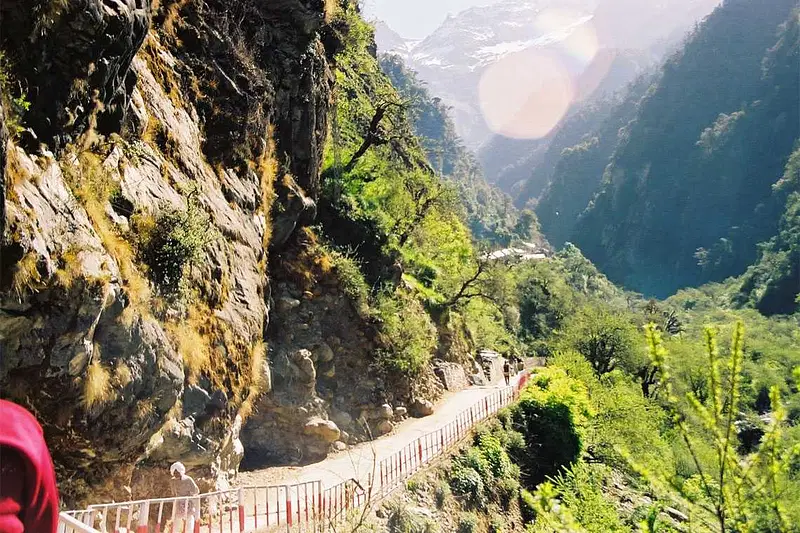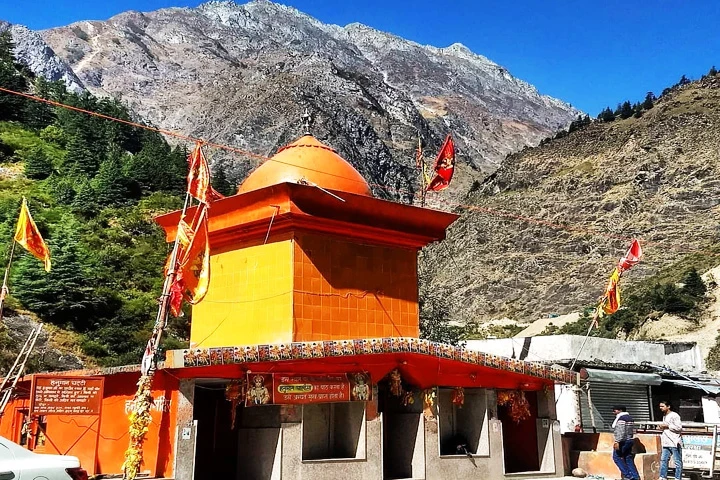Exploring Yamunotri Temple: The Holy Origin of River Yamuna
Yamunotri Temple, located in the Garhwal Himalayas of Uttarakhand, is among the Char Dham shrines and the holy birthplace of the River Yamuna. The temple, dedicated to the Goddess Yamuna, is located at an elevation of 3,293 meters, with spectacular views of snow-covered peaks and tranquil landscapes. It was constructed by Maharaja Pratap Shah of Tehri Garhwal and has strong spiritual value in Hinduism. Pilgrims embark on a 6 km walk from Janki Chatti, covering barren landscapes and verdant valleys, to acquire blessings. The Surya Kund hot springs, where pilgrims boil rice as an offering to the goddess, further contribute to its spiritual beauty. Visiting Yamunotri is a spiritual expedition but also an opportunity to witness nature’s divine beauty and peaceful tranquility in the arms of the Himalayas.
Book here Chardham Yatra Packages
Mythological & Religious Significance of Yamunotri Temple
Yamunotri is revered as the sacred origin of the River Yamuna, one of Hinduism’s holiest rivers. According to mythology, Goddess Yamuna, daughter of Surya Dev (Sun God) and sister of Yama (God of Death), grants devotees protection from untimely death. Sage Asit Muni, who meditated here, was blessed when the Ganga appeared beside Yamuna to ease his devotion. The Surya Kund, a natural hot spring, is believed to be a gift from Surya Dev, where pilgrims cook rice as a sacred offering. Bathing in the holy waters of Yamuna is said to cleanse sins and bring spiritual salvation to devotees.
Best Time to Visit Yamunotri Temple
The ideal time to visit Yamunotri is between May and June and September and October when the climate is favorable and conducive to travel. The temple is open in May on Akshaya Tritiya and is open till Diwali, after which it is closed because of snowfall. The monsoon months of July and August are marked by heavy rains, landslides, and roadblocks, and traveling becomes unsafe. Winters (November to April) are bitterly cold, with the area snow-covered, and the temple is not accessible. For a safe and comfortable pilgrimage, traveling in the summer and post-monsoon seasons is strongly advised.
How to Reach Yamunotri Temple
By Air
The nearest airport to Yamunotri is Jolly Grant Airport in Dehradun, which is well-connected to major Indian cities. From the airport, pilgrims need to travel by taxi or bus to Hanuman Chatti, the base point for the trek. The journey from Dehradun to Hanuman Chatti takes around 7-8 hours, covering scenic mountain roads. It is advisable to book transport in advance during peak pilgrimage seasons.
By Train
The closest railway station is Rishikesh, located around 200 km from Yamunotri. Rishikesh is well-linked with Delhi and other major cities through regular trains. From the railway station, pilgrims can take buses or taxis to reach Barkot or Hanuman Chatti. Since trains to Rishikesh can be in high demand, booking tickets early is recommended.
By Road
Yamunotri is accessible by road up to Janki Chatti, which serves as the last motorable point. Buses and taxis from Rishikesh, Haridwar, Dehradun, and Uttarkashi frequently operate on this route. The road journey passes through Barkot, a common stopover for travelers. From Janki Chatti, the only way to reach the temple is by trekking.
Top Places of Yamunotri Temple
1. Janki Chatti

Janki Chatti is the last motorable point before the trek to Yamunotri Temple begins. This small town is famous for its natural hot water springs, where pilgrims take a holy dip before starting their journey. It is surrounded by snow-capped mountains and lush greenery, offering a peaceful environment. Many travelers choose to stay overnight in Janki Chatti due to the availability of guesthouses and basic facilities. The town serves as a perfect resting and acclimatization spot for pilgrims.
2. Surya Kund

Surya Kund is a naturally boiling water spring near the Yamunotri, believed to be a divine blessing from Surya Dev (Sun God). Pilgrims cook rice and potatoes in steaming water, which are later taken as Prasad from the temple. The spring’s high temperatures and its spiritual significance make it an important religious site. Devotees believe that the holy water has medicinal properties that help cure ailments. Visiting Surya Kund is a unique and sacred experience for pilgrims.
3. Divya Shila

Divya Shila is a sacred rock pillar located near the entrance of the Yamunotri. According to tradition, devotees must offer prayers here before entering the temple to seek divine blessings. It is believed that worshiping at Divya Shila purifies the soul and enhances the spiritual connection with Goddess Yamuna. The stone holds mythological significance as it is said to carry divine energy. The site is an essential stop for pilgrims visiting Yamunotri.
4. Hanuman Chatti

Hanuman Chatti is a beautiful riverside town at the confluence of the Hanuman Ganga and Yamuna rivers. It serves as the base point for treks to Yamunotri and Dodital, making it an important place for pilgrims and trekkers. The town is known for its calm surroundings and religious significance, attracting nature lovers and spiritual seekers alike. There is a small Hanuman Temple where devotees stop to pray before continuing their journey. Hanuman Chatti offers basic accommodation and food options for travelers.
5. Saptarishi Kund

Saptarishi Kund is a high-altitude glacial lake believed to be the true origin of the River Yamuna. The lake is surrounded by rugged terrain and rare Himalayan flora, making it a paradise for nature lovers and experienced trekkers. The trek to Saptarishi Kund is challenging and adventurous, requiring good physical fitness. The pristine blue waters and breathtaking scenery make it one of the most stunning places near Yamunotri. Though difficult to reach, it is a hidden gem worth exploring for adventure seekers.
Accommodation & Facilities in Yamunotri Temple
1. Guesthouses and Dharamshalas: Several guesthouses and dharamshalas in Janki Chatti and Hanuman Chatti offer basic accommodations for pilgrims. These lodges provide simple rooms, bedding, and vegetarian meals at affordable prices. Since facilities are limited, it is best to book in advance during the peak pilgrimage season.
2. Budget and Mid-Range Hotels: Pilgrims can find budget and mid-range hotels in Barkot, Hanuman Chatti, and Janki Chatti with decent facilities. These hotels offer comfortable rooms, hot water, and sattvic meals, ensuring a convenient stay. Due to high demand, pre-booking hotels is recommended during the Char Dham Yatra.
3. GMVN Tourist Rest Houses: The Garhwal Mandal Vikas Nigam (GMVN) operates government-run guesthouses in Barkot, Janki Chatti, and Hanuman Chatti. These affordable lodges provide clean bedding, basic amenities, and a peaceful stay. Since they are popular, early booking is necessary to secure a spot.
4. Food and Dining Facilities: Several small eateries and dhabas near Janki Chatti and the trekking route serve vegetarian meals. Pilgrims can enjoy simple North Indian dishes like dal, roti, and rice in these food stalls. Carrying snacks and water is recommended, as food options are limited during the trek.
5. Medical and Emergency Services: Basic medical facilities and first-aid centers are available in Janki Chatti and Hanuman Chatti for emergencies. Local shops sell essential medicines, but carrying a personal medical kit is advised. In case of serious health issues, the nearest hospital is in Barkot, about 50 km away.
Travel Tips for Yamunotri Temple
1. Plan Your Visit: Yamunotri Temple remains open from April/May to October/November, so plan your trip during these months. Avoid the monsoon season, as heavy rainfall can cause landslides and roadblocks.
2. Pack Warm Clothing: Even during summer, temperatures can drop significantly, so carry warm clothes. Layered clothing, gloves, and raincoats are essential for cold weather and sudden rains.
3. Choose Comfortable Footwear: Since reaching Yamunotri requires a 6 km trek from Janki Chatti, wear sturdy and comfortable trekking shoes. Good grip shoes will help navigate the rocky and uneven terrain safely.
4. Stay Hydrated and Carry Snacks: The trek can be exhausting, so carry a water bottle and energy snacks to stay energized. Avoid plastic waste and use reusable bottles and eco-friendly packaging.
5. Acclimatize Before the Trek: Spend a day in Barkot or Janki Chatti to adjust to the high-altitude conditions. Acclimatization helps prevent altitude sickness and ensures a smooth trek.
6. Hire a Pony or Palki if Needed: For those unable to trek, ponies, palkis, and palanquins are available from Janki Chatti. It is advisable to book these services in advance during peak pilgrimage season.
7. Carry Essential Medications: Medical facilities are limited, so bring personal medicines, first-aid kits, and altitude sickness tablets. Consult a doctor before traveling if you have any health concerns.
Conclusion
Yamunotri Temple, located within the peaceful Himalayas, is a site of immense spiritual importance and natural splendor. Being the divine birthplace of the holy Yamuna River, it welcomes thousands of pilgrims in search of blessings from God and peace of mind. The pilgrimage to the temple, either by trek or palki ride, is as spiritually invigorating as the temple itself. With its mythological significance, scenic beauty, and serene environment, Yamunotri is a heavenly experience. A trip to this sacred temple is not merely a pilgrimage but an experience of the soul for faith, devotion, and the serenity of nature.
Here you can also check our Chardham Yatra Packages.
People also ask about the Yamunotri Temple
1. What is the significance of Yamunotri Temple?
Yamunotri is dedicated to Goddess Yamuna, the sacred river believed to purify the soul. It is one of the Char Dham pilgrimage sites and marks the origin of the Yamuna River.
2. When is the best time to visit Yamunotri Temple?
The best time to visit is May to June and September to October when the weather is pleasant. Avoid the monsoon season (July–August) due to heavy rainfall and landslides.
3. How can I reach Yamunotri Temple?
You can reach Yamunotri by road up to Janki Chatti and then trek 6 km to the temple. Nearest airport: Jolly Grant Airport, Dehradun; nearest railway station: Rishikesh.
4. Is trekking necessary to reach Yamunotri Temple?
Yes, a 6 km trek from Janki Chatti is required to reach the temple. However, ponies, palkis, and palanquins are available for those unable to walk.
5. Are accommodation facilities available near Yamunotri?
Yes, there are guesthouses, dharamshalas, GMVN rest houses, and budget hotels in Janki Chatti, Hanuman Chatti, and Barkot. Pre-booking is recommended during peak season.
6. What are the nearby attractions to visit?
Nearby attractions include Janki Chatti, Surya Kund, Divya Shila, Hanuman Chatti, and Saptarishi Kund. These places offer spiritual, scenic, and adventurous experiences.
7. Are food facilities available near the temple?
Yes, small dhabas and eateries serve pure vegetarian food in Janki Chatti and along the trek route. It’s advisable to carry snacks and water for the journey.
8. What should I pack for the Yamunotri trip?
Pack warm clothes, trekking shoes, rain gear, a medical kit, water bottles, and energy snacks. The weather can be unpredictable, so layered clothing is essential.
9. Is photography allowed inside the temple?
Photography inside the main temple premises may be restricted. It is best to respect local customs and follow temple guidelines before taking photos.
10. Is a mobile network available in Yamunotri?
Mobile connectivity is limited and weak in Yamunotri, especially for internet services. It is advisable to inform the family and make the necessary arrangements beforehand.
